In a stopped-flow apparatus, two separated solutions contained in two drive syringes are rapidly mixed into a chamber and stopped by a stop syringe. In the mixing chamber a spectroscopic signal change is recorded as a function of time. Stopped flow instruments can record signal changes in absorbance, fluorescence, and/or circular dichroism. Detection of different fluorescence emission wavelength ranges can be selectively obtained through the use of specific optical filters.
Drive syringes can be set up with different volumes (e.g., 0.25ml – 2.5ml) and stoichiometrical ratios (1:1 – 1:6 – 1:11). All stopped-flow apparatus allow the time resolution of fast reaction kinetics, occurring in the millisecond time range, as well as slow reaction kinetics.
Generally suitable to monitor fast kinetics of reactions involving protein-protein interactions, protein (un)folding, enzyme activity, ligand binding, Forster resonance energy transfer (FRET).
What are the sample requirements?
- Pure samples are preferred.
- Protein concentrations may vary for different types of experiments and should be discussed with the TNA site. However, typical concentrations will be 0.1 mg/ml or less and 1-2 mL of sample will be required for a single experiment.
- For CD measurements avoid using highly absorbing buffers.
Partners offering this technique
MOSBRI reference partner site for this technique:
Other partners:
